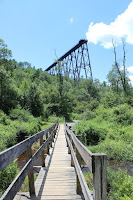I had planned a trip to
north-central Pennsylvania for a while and finally had a chance to
seek out a few attractions. Two of the major things I had wanted to
see for some time were the Austin Dam and Kinzua Bridge. With a great
weather forecast ahead, my brother, a friend, and I started our trip
to Kinzua Bridge. The drive lead us through one of the most wooded
parts of Pennsylvania with towering trees and a lot of wild life. The
drive in itself was easy and scenic and time pasted quickly as we
approached the Kinzua State Park.
 Marketed as the “Eight Wonder of
the World” at one point, the Kinzua Bridge was a historic
architectural marvel. The railroad bridge was built over the Kinzua
Creek in Meckean County just outside the small town of Mt. Jewett. At
one time it was the tallest railroad bridge in the world standing
over 300 feet. Originally built in 1882 of wrought iron, it was later
rebuilt with steel. It remained working until 1959 and then
became part of the Kinzua State Park. Restoration efforts for the
bridge to attract more visitors started in 2002, but in 2003 a huge
storm ripped through northern Ohio and Pennsylvania and proceeded to
build a tornado that knocked down most of the bridge. After the
destruction, plans changed to make the bridge a sky walk to
show the power of mother nature.
Marketed as the “Eight Wonder of
the World” at one point, the Kinzua Bridge was a historic
architectural marvel. The railroad bridge was built over the Kinzua
Creek in Meckean County just outside the small town of Mt. Jewett. At
one time it was the tallest railroad bridge in the world standing
over 300 feet. Originally built in 1882 of wrought iron, it was later
rebuilt with steel. It remained working until 1959 and then
became part of the Kinzua State Park. Restoration efforts for the
bridge to attract more visitors started in 2002, but in 2003 a huge
storm ripped through northern Ohio and Pennsylvania and proceeded to
build a tornado that knocked down most of the bridge. After the
destruction, plans changed to make the bridge a sky walk to
show the power of mother nature. |
| Visitor Center |
As we arrived to the parking lot
for the sky walk, we were surprised to see a large visitor center. We
decided to go straight to the sky walk which was directly behind the
visitor center and check back there afterwards. For a Sunday, the
park was busy but not overly crowded. Along the sky walk, we quickly
progressed high above the tree tops and valley below. At the end of
the bridge a large observation platform was built with a glass floor
in the middle. We stood 250 feet above the valley with superb view of
the valley. We then decided to walk the trail leading to the valley
below. The trail itself was steep and one could easily become
fatigued if not used to hiking, so I would recommend using caution
before attempting. The views from the valley floor were almost as
amazing as from above and worth the trip down.
 Upon returning from the trail, we
decided to stop by the visitor center and were glad we did. The
center had many exhibits, some were hands on and great of grade
school children. The visitor center also had an information desk and
small gift shop. Overall I was very pleased with the trip and would
recommend a visit to anyone to see this engineering marvel.
Upon returning from the trail, we
decided to stop by the visitor center and were glad we did. The
center had many exhibits, some were hands on and great of grade
school children. The visitor center also had an information desk and
small gift shop. Overall I was very pleased with the trip and would
recommend a visit to anyone to see this engineering marvel.











